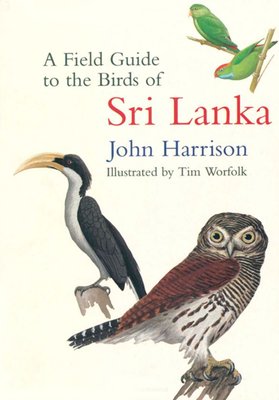Monday 07th December 2009 12:00:00 AM

|
A Field Guide to the Birds of Sri Lanka
John Harrison and Tim Worfolk, Oxford University Press.
340 pages, 48 colour plates [426 species], colour
illustrations; ISBN: 0198549601.
|
|
A Field Guide to the Birds of Sri Lanka is the first fully comprehensive, modern field guide to this ornithologically fascinating country. All of Sri Lanka's 426 official avian species are described in the text and depicted in 48 stunning new colour plates painted by Tim Worfolk, one of Britain's leading bird artists. The text, accessible to both experienced ornithologists and beginners, highlights the important identification features, such as plumage variations, size, calls and songs, range, distribution, and status, for every species. The plates illustrate the various plumage variations for each bird, and show the birds perched and also in flight, where relevant to their identification.
|
|
An introduction to the guide describes briefly some of the best sites for watching Sri Lanka's abundant avifauna, and provides useful contact addresses for the prospective traveller. This will be an essential purchase for all birdwatchers travelling to the region; the beautiful plates and clearly-written text will also make it a must-have for anyone who loves birds, and Sri Lankan birds in particular.
About the Author
John Harrison has had a lifelong interest in wildlife, and birds in particular. In 1973, he was appointed as a radio producer in the BBC Natural History Unit; during the 18 years he was there, he worked with most of the top naturalists and ornithologists in Britain. As a birdwatcher and wildlife enthusiast, he has made many visits to Sri Lanka over a number of years, and has a first-hand knowledge of the Sri Lankan avifauna. He is now the voluntary warden of a 70 ha wetland nature reserve for the Avon Wildlife Trust.
Tim Worfolk is a full-time wildlife artist with several publications to his credit. Amongst others, he has worked on the Handbook of the Birds of the World, Pica Press Shrikes of the World, Birds of South-East Asia published by New Holland, and Birds of the Indian Subcontinent, by Black.
|
|
It is one of the expensive
field guides I have even bought for birding in term of the price for
each page (over £40 including the shipping charge to Hong Kong for just over 300 page). However, it is still worthwhile having one if a small,
handy comprehensive field guide only for Sri Lanka is wanted. This
guide book (printed in China) is not available in Sri Lanka except the
copy printed in India with bad colour reproduction as mentioned by the
local bird guide I hired, who still surprised my order of this book from
Amazon before
my trip to Sri Lanka. According to my bird guide there, it
is still a recommended identification guide though it unfortunately does
not include the latest identified endemic,
Serendib Scops-owl, and some of the endemic sub-species. It is a
good news that the newer second edition will be published after January
2011 and hopefully it will include additional and up-to-dated
information but selling in a lower price (as quoted in
NHBS). Given only a few field guides focusing on Sri Lanka
available in the bookstore, I don't regret getting this book just before
my trip to Sri Lanka and birdwatching such a delightful country should definitely be done with this book. A good review on this book as shown below written
by
Soleglad at
Avian Review/Avian Books in October
2008 can also be referred:
|
|
Of the few
field guides that cover only Sri Lanka, this is easily the best
book for several reasons. One, it's the only Sri Lanka guide to
illustrate all the birds of the island, versus just the resident birds.
Two, the artistry in the plates is very good and many more plumages are
displayed. And, three, the text contains more information for
identification and offers tips to distinguish between similar species.
Each plate
contains between 4 and 15 different species. Most plates contain about
10. On each plate are anywhere between 15 and 40 different
illustrations. As an extreme, the plate for the harriers contains only 4
species but over 40 different illustrations, which makes the images
slightly small and for a busy page. This scenario is true for most of
the raptors, gulls, terns, and shorebirds. However, I'll take this slightly crammed plate with all the many plumages over a more limited selection of views.
Across from each
plate are brief notes (1-4 lines) on the identification of the bird. A
small range map of Sri Lanka is also supplied. Due to the small size of
the island, the ranges are generalized and look much the same between
all the birds. These are only somewhat useful.
The final 2/3 of
the book contains the species accounts. The bulk of information revolves
around identification of the bird and comparisons to similar species.
This information is fairly detailed and offers good notes to identify
the bird. Other brief information is given for the voice,
status/distribution, habitat, and range.
Any birding done
in Sri Lanka should be done with this book in your hand. It is both a
good book and, the best one available for just this area. A few other
all-India books would also work, but they would be overkill for the
island. |
|


